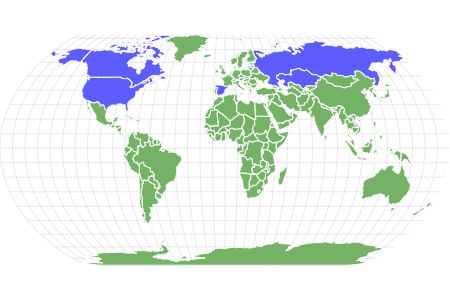Lynx
Felis lynx
Live in dens in rocks and under ledges!
Advertisement
Lynx Scientific Classification
- Kingdom
- Animalia
- Phylum
- Chordata
- Class
- Mammalia
- Order
- Carnivora
- Family
- Felidae
- Genus
- Lynx
- Scientific Name
- Felis lynx
Read our Complete Guide to Classification of Animals.
Lynx Conservation Status
Lynx Facts
- Main Prey
- Hare, Birds, Deer
- Habitat
- Secluded forests and mountainous regions
- Predators
- Wolf, Coyote, Human, Cougar
- Diet
- Carnivore
- Average Litter Size
- 4
As solitary and stealthy predators, the lynx is rarely seen by humans.
The Canada lynx is one of the biggest wild cats in North America, but other species of these cats also inhabit Europe and Asia. The lynx is easy to spot with its huge furry paws, stubby tail, and long ear tufts. The huge paws serve as natural snowshoes to help them navigate the snowy, cold forests and mountains it calls home.

An Incredible Animal: 4 Lynx facts!
- Lynx are solitary animals that typically only come together for mating
- Four species of these cats are found in many places around the world, including North America, Russia, Europe, and Asia
- The lynx is an opportunistic predator that will generally eat any prey that it is capable of killing
- Lynx are animals that are easily recognizable by their large paws, tufted ears, stubby tail, and grayish-brown coat colors
You can check out more incredible facts about lynxes.
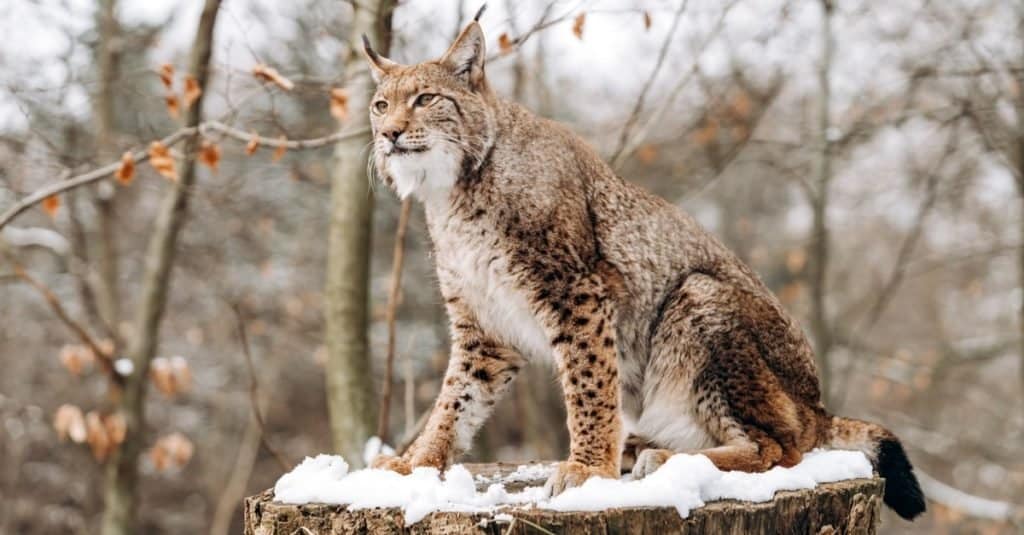
Canada Lynx sitting in a tree on a sunny day.
©Ewa Studio/Shutterstock.com
Scientific name
Lynx refers to four species of stubby-tailed wild cats that live in the cold forests of North America, Europe, and Asia. All of these animals belong to the class Mammalia, the order Carnivora, the suborder Feliformia, the family Felidae, and the subfamily Felinae. The name lynx is part of the scientific name of each of the four species. It originates from an old Greek word that meant light or brightness. The term is thought to refer to the lynx’s bright, reflective eyes.
The four species of these animals are as follows:
- Canada lynx (L canadensis) This wildcat has broad, horse-shoe like paws and dense fur for living in a snowy Canadian climate. Prefered prey is snowshoe hare.
- Bobcat (L rufus) Native to North America and adapted to living in the warmer climates of the United States, the Bobcat lacks the tufted ears and broad paws of its Canadian cousins.
- Eurasian lynx (Lynx) This solitary cat is nocturnal and spends the day sleeping in dense thickets. Their superior eyesight enables them to spot a mouse 250 feet away. They can be found all over Europe, Russia and into Asis.
- Iberian lynx (L pardinus) This endanger cat once enjoyed a wider range but can only be found in Spain.
Evolution
The first mammals are believed to have lived 208 million years ago – after the extinction of dinosaurs. The first carnivores came from animals known as miacoids about 60 million years ago. These tree dwellers were about the size of a domestic cat and had developed sharp crushing teeth. Miacoids are the oldest relative to the modern-day lynx.
Carnivores split into two groups – Carniformia and Feliformia – around 40 million years ago. The Carniformia group was more bear-like and evolved into bears, dogs, weasels, raccoons, skunks, badgers, sea lions, walruses, and seals. Feliformia was more cat-like and evolved into cats, hyenas, and mongooses.

The Eurasian Lynx entered North America across the Bering Strait Land Bridge about 2.5 million years ago.
©iStock.com/Korbinian Mueller
Proailurus, the oldest cat, appeared in France 30 million years ago. This aboreal creature weighed around 25 pounds and had eight more teeth than modern cats. 20 Million years ago, the direct ancestor of modern cats, Pseudaelurines, was found in the fossil record. Around 1.6 million years ago, the saber-tooth tiger, Smilodon, was found in fossil records discovered in the La Brea tar pits in California. These big cats became extinct around 10,000 years ago.
The oldest lynx remains, approximately four million years old, were found in Africa. The ancestor of the four lynx species is believed to be Lynx issiodorensis, which was distributed all over the northern hemisphere. The Eurasian Lynx entered North America across the Bering Strait Land Bridge about 2.5 million years ago. The different lynx species evolved to suite their environments – resulting in the four species that exist today.
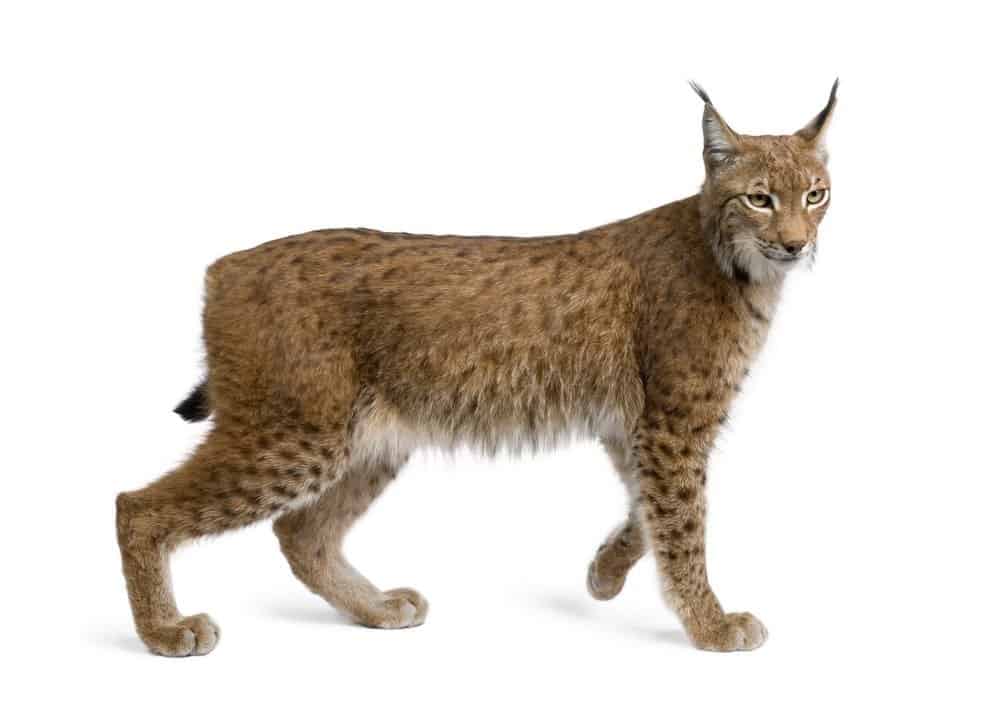
The most notable features of lynx are their huge paws, tufted ears, and stubby tail.
©Eric Isselee/Shutterstock.com
Appearance
The most notable features of these cats are their huge paws, tufted ears, and stubby tail. The color of the animal varies depending on the species. The body color follows a gradient of medium brown to golden brown to as light as grayish-white. A furry ruff is found in all species. It’s usually marked with black bars that look like a bowtie, but it’s not always visible. All species have white fur on the undersides of their bodies.
The size and weight of the animal depend on the species. The Eurasian lynx is the largest with males weighing between 40 and 66 pounds. It stands roughly 27 inches at the shoulder. The Canada lynx weighs between 18 and 31 pounds and stands between 19 and 22 inches at the shoulder. The Iberian lynx weighs 28 pounds for males and 20 pounds for females. Height varies between 23 and 27 inches at the shoulder. The bobcat weighs between 16 and 30 pounds and stands between 20 and 24 inches at the shoulder.
Bobcats are technically part of the lynx species, but they look a bit different compared to the other three species. They typically do not have long ear tufts, and their paws aren’t as obviously large and padded due to their common habitat in warmer climes. The bobcat’s scientific name, rufus, alludes to its reddish-brown coloring, and it often has prominent black spots as well.

Bobcats typically do not have long ear tufts, and their paws aren’t as obviously large and padded due to their habitat in warmer climes.
©iStock.com/twildlife
Behavior
These cats are typically solitary animals. Rarely, small groups of these cats will travel together and hunt prey. They usually live in dens burrowed into ledges or rocky crevices. This is where they raise their kittens as well. A lynx won’t usually take its food back to its den unless it is a mother that needs to feed her kittens. These animals are very stealthy and good at avoiding human settlements, which is why they’re rarely seen.
Habitat
Most species roam high-altitude forests that offer plenty of protection with dense shrubs, trees, and tall grass. Even though this wild cat generally hunts on the ground, it’s fully capable of climbing trees and swimming. The Eurasian lynx lives in central and northern Europe and over to India, northern Pakistan, and Iran near Mount Damavand. This species is most commonly found in northern European countries like Norway, Finland, and Sweden as well as most of Russia.
The Iberian lynx is far rarer and lives only in the southern parts of Spain. It used to live in eastern Portugal as well but became extinct there.
The Canada lynx mainly lives in Canada and Alaska but is also found in some northern US states like Washington, Montana, and Maine. Its habitat is primarily boreal forests, which are also known as snow forests and consist largely of coniferous trees.
The bobcat ranges further than the Canada lynx. It is found in southern Canada, most of the continental United States, and as far south as northern Mexico. It lives in both forests and grasslands.

Diet
This animal is an opportunistic predator and can hunt a wide range of animals. It is a strict carnivore. The Canada lynx strongly prefers the snowshoe hare, and its population numbers fluctuate with the availability of the hare. However, it will also hunt fish, squirrels, rabbits, birds, grouse, turkey, and more. The larger Eurasian lynx often hunts larger animals such as deer, reindeer, and even elk.
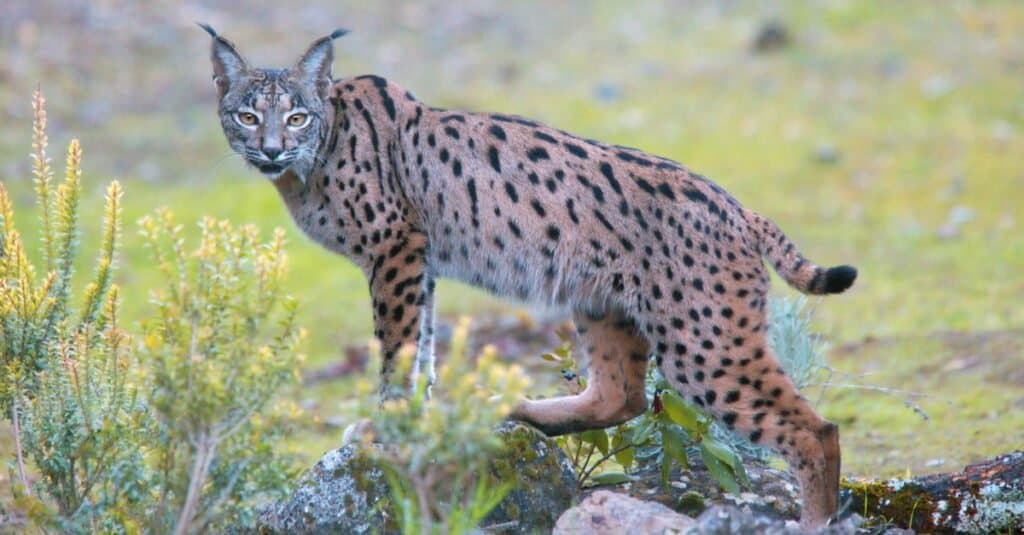
The Iberian Lynx is the most threatened of these cat species. In 2004, only 100 animals lived in southern Spain.
©tony mills/Shutterstock.com
Predators and threats
These animals are primarily threatened by other predators larger than it as well as humans. The Eurasian lynx is one of the largest predators in Europe, with only the gray wolf and brown bear being larger. In North America, the cougar, gray wolf, and coyote pose threats to the lynx. Humans have often hunted lynx for their fur, but some species are now protected, depending on the region. The Eurasian and Canadian lynx are most vulnerable to loss of habitat. Both are also dependent on prey numbers remaining healthy. The bobcat is the least endangered of all lynx species, and its numbers remain well into the hundreds of thousands despite being actively hunted by humans.
The Iberian lynx is the most threatened of these cat species. In 2004, only 100 animals lived in southern Spain. Thanks to conservation efforts by the Spanish government, they have somewhat recovered. As of 2014, over 300 animals were found in the same area.

Lynx kittens weigh between 6.2 and 8.3 ounces at birth and do not open their eyes for 14 days.
©mlorenz/Shutterstock.com
Reproduction, Babies, and Lifespan
The Eurasian lynx mates between January and April with the female having one oestrus period for four to seven days during this time. Males make deep growls to alert potential mates to their presence, while females make softer meow sounds. Pregnant females looking for secret locations to build their nests, which are often in caves or dens. Gestation lasts between 67 and 74 days and usually results in two kittens. Three or more lynx in a litter are rare. These baby lynxes -or kittens -are between 8.5 and 15.2 ounces. They are covered in grayish-brown fur and gain full adult color by 11 weeks. Their eyes open after about 10 days. They can eat solid food at around six weeks but are not fully weaned until at least five months. The mother lynx leaves the den at two or three months after birth, and the kittens accompany her until they reach 10 months.
The Canada lynx has a one-month mating season between March and April. Mating calls and marking with urine are typical matings behaviors. Gestation is between two and three months and the resulting litter can be one kitten or as many as eight. Litter sizes appear to vary depending on the availability of prey. The kittens weigh between 6.2 and 8.3 ounces and do not open their eyes for 14 days. These kittens also leave their mothers around 10 months.

This baby lynx is learning to pounce.
©Stanislav Duben/Shutterstock.com
The Iberian lynx litter is born between March and September after a two-month gestation period. The majority of births are in March and April. These kittens weigh between 7 and 8.8 ounces. By 10 months, the kittens are mostly independent, but many remain with the mother until about 20 months of age. They are known to get into violent fights with each other, which often leads to death. This starts to happen between 30 and 60 days of age.
Bobcats usually mate between February and March. A male bobcat will travel with one female and mate with her several times. The female bobcat will raise the kittens alone after birth. Bobcat litters generally consist of two to four kittens but can be as many as six. Gestation lasts 60 to 70 days, and usually results in an April or May birth. Bobcat kittens open their eyes around nine days and are weaned by two months. Between three and five months of age, they begin to leave the den and travel with the mother bobcat.
The Eurasian lynx has lived up to 21 years in captivity. The Canada lynx is known to live up to 27 years in captivity and between 10 and 16 years in the wild. The bobcat lives between 7 and 10 years in the wild, with one notable exception being 16 years. In captivity, the oldest bobcat lived 32 years. Iberian lynx have a maximum wild lifespan of 13 years.

The Iberian lynx has an endangered conservation status.
©iStock.com/RamonCarretero
Population
The Canada and Eurasian lynx and bobcat have a conservation status of least concern. The Iberian lynx is considered endangered. As of 2015, 400 Iberian lynx live on the Iberian peninsula. The United States population of bobcats is estimated to be several hundred thousand. The Eurasian lynx population is thought to be around 45,000 and is considered generally stable. The Canada lynx population is also stable and is thought to be in the tens of thousands.
In the Zoo – Where to Find the Lynx
The Canada lynx and the bobcat are the most common of these cats in United States zoos. They are easily found in zoos all over the country, including the following:
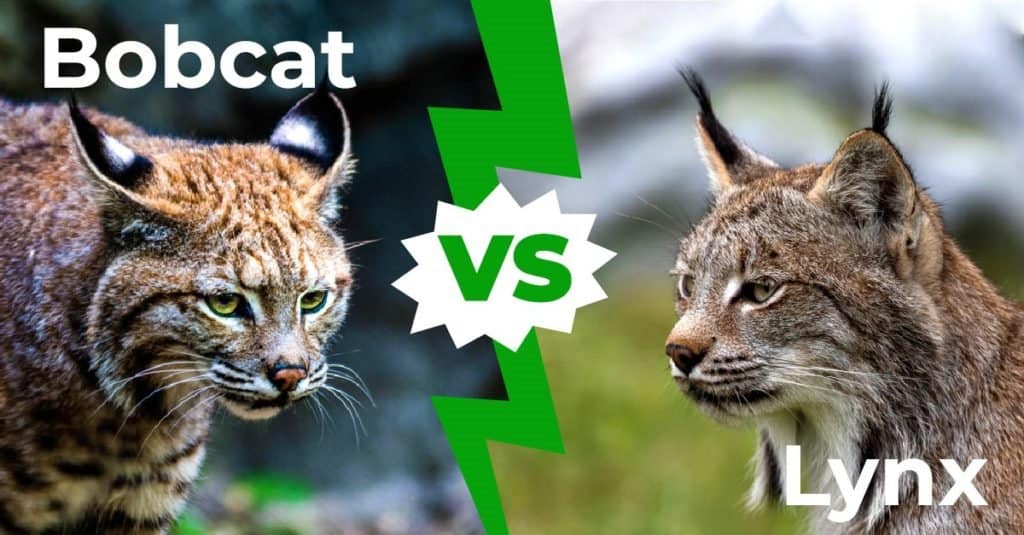
Lynx vs. Bobcat
The bobcat is a species of lynx, but its appearance is easily distinguishable from the Canada lynx, with which it shares some range. The bobcat typically has prominent black spots and tawny fur. Its fur is also less thick, and it doesn’t have long ear tufts or the huge paws of a Canada lynx. The bobcat is found in nearly any type of habitat and ranges over the entire United States and southern parts of Canada. The Canada lynx is mostly found in snow forests in Canada and parts of the northern U.S.
View all 98 animals that start with LLynx FAQs (Frequently Asked Questions)
What is a lynx?
A lynx is a medium-sized wild cat that lives in North America, Russia, parts of Europe, and parts of Asia.
How fast does a lynx run?
The top speed of a lynx is 50 mph.
Where do lynx live?
The Canada lynx lives primarily in Canada, Alaska, and some parts of the northern United States. The bobcat can be found in every part of the United States as well as southern Canada and most of Mexico. The Iberian lynx is only found in southern Spain. The Eurasian lynx lives in Russia, Scandinavia, parts of Europe, parts of Turkey, and northern areas of China and Tibet.
What do lynx eat?
The lynx eats deer, rabbits, rodents, sheep, squirrels, ground birds, other birds, goats, reptiles, and fish. The Canada lynx strongly prefers snowshoe hare, while other species are more opportunistic and will eat whatever is in their habitat.
Can you have a lynx as a pet?
Most states in the United States declare that it is illegal to own any species of lynx. However, Alabama, Nevada, North Carolina, South Carolina, and Wisconsin allow bobcats to be kept as pets.
Is a lynx dangerous/can it kill you?
A lynx will defend itself if cornered, but there are no recorded instances of unprovoked attacks on humans. A large lynx could, in theory, kill a human.
Do lynx eat cats?
A lynx is an opportunistic predator, and domestic cats are well within the size of prey it normally eats.
What Kingdom do Lynx belong to?
Lynx belong to the Kingdom Animalia.
What class do Lynx belong to?
Lynx belong to the class Mammalia.
What phylum to Lynx belong to?
Lynx belong to the phylum Chordata.
What family do Lynx belong to?
Lynx belong to the family Felidae.
What order do Lynx belong to?
Lynx belong to the order Carnivora.
What type of covering do Lynx have?
Lynx are covered in Fur.
What genus do Lynx belong to?
Lynx belong to the genus Lynx.
What are some predators of Lynx?
Predators of Lynx include wolves, coyotes, humans, and cougars.
How many babies do Lynx have?
The average number of babies a Lynx has is 4.
What is an interesting fact about Lynx?
Lynx live in dens in rocks and under ledges!
What is the scientific name for the Lynx?
The scientific name for the Lynx is Felis lynx.
What is the lifespan of a Lynx?
Lynx can live for 12 to 20 years.
What are the differences between caracals and lynx?
The key differences between a caracal and a lynx are size, color, physical features, danger, habitat, lifespan, and diet.
How to say Lynx in ...
Thank you for reading! Have some feedback for us? Contact the AZ Animals editorial team.
Sources
- David Burnie, Dorling Kindersley (2011) Animal, The Definitive Visual Guide To The World's Wildlife / Accessed November 10, 2008
- Tom Jackson, Lorenz Books (2007) The World Encyclopedia Of Animals / Accessed November 10, 2008
- David Burnie, Kingfisher (2011) The Kingfisher Animal Encyclopedia / Accessed November 10, 2008
- Richard Mackay, University of California Press (2009) The Atlas Of Endangered Species / Accessed November 10, 2008
- David Burnie, Dorling Kindersley (2008) Illustrated Encyclopedia Of Animals / Accessed November 10, 2008
- Dorling Kindersley (2006) Dorling Kindersley Encyclopedia Of Animals / Accessed November 10, 2008
- David W. Macdonald, Oxford University Press (2010) The Encyclopedia Of Mammals / Accessed November 10, 2008
- National Geographic / Accessed November 18, 2020
- The Nature Conservancy / Accessed November 18, 2020
- Britannica / Accessed November 18, 2020
- Wikipedia / Accessed November 18, 2020
- Find an Answer / Accessed November 18, 2020

